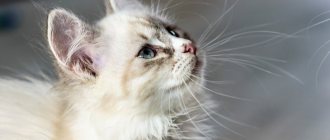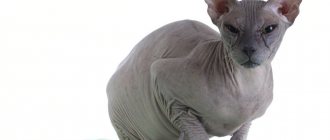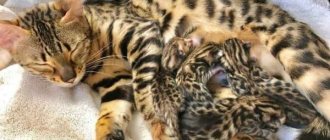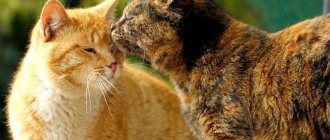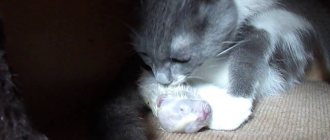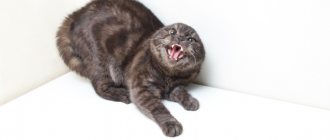How puberty occurs
Sexual maturity is the age at which an animal can participate in the process of reproduction. Hormones are produced in his body, gametes - the first cells of possible embryos - mature. In females, the first estrus occurs at 5–8 months, males come into season a month and a half later. An interesting fact is that kittens that were born at the beginning of the sexual season become sexually mature later than those born in the final period. The timing of puberty is strongly influenced by the general state of health, feeding and housing conditions, and social adaptation.
Most often, the first heat occurs at about six months of age, but some breeds have nuances. Short-haired cats are characterized by an early onset of heat - five months, in exceptional cases - three and a half. This is especially true for Siamese cats - nature has endowed them with a violent temperament.
Siamese cats are especially playful
On the contrary, in color-point and Persian cats, estrus can linger for up to ten to fifteen months. This is completely normal and not worth worrying about.
There are several other patterns noticed while observing cats. So, if the first heat is expected in winter (during the passive sexual period), then, most likely, its onset will be delayed until spring. Late maturation occurs if the animal is kept in a darkened room. A bright room and being surrounded by other mature animals speeds up maturation.
How to understand that heat has begun
In the first days, the cat becomes very affectionate and restless, actively rubs against furniture, rolls on the floor and goes to the litter box more often than usual. She leaves marks around the apartment that contain valeric acid. This is a pheromone that has a stimulating effect not only on cats, but also on cats that have not yet come into heat. The vulva swells slightly and the cat licks itself frequently. There should not be any heavy discharge.
Stroke me, man!
After two or three days, these signs intensify: the cat crawls and rolls on the floor and moans pitifully . The most unbearable and piercing howls are made by Siamese cats. If at this moment you stroke her on the withers, the cat instantly takes a mating position: arches her back, raises her tail and moves it to the side, spreads along the ground and makes kneading, trampling movements with her hind legs. He eats little and may try to escape outside. The signs are enhanced if the scent of an adult male is present in the area, and are more pronounced in short-haired breeds than in long-haired ones. This stage is called estrus and is the most favorable for conception.
“I had a short-haired mongrel cat Kasya. Her heats lasted for several weeks, anti-rut medications did not help, and the screams were terrible and so tiring that you wanted to throw something at the languishing animal. Before sterilizing, I decided to let her give birth once - there was such a misconception before. We tried to set her up with the neighbor's cat. Despite the continuation of her heat, Kasya behaved aggressively and clearly defended the territory, and the cat was in no hurry to get to know each other better and behaved warily. And after some time, the sounds of a fight coming from the visiting room forced me to take out the “groom”, who was pretty shabby. The “bride” nervously licked her lips and sparkled her eyes, clearly not wanting to continue. Alas, my attempt was unsuccessful. The point was that I did not know certain rules that must be followed to successfully breed cats.”
Siamese cats are famous for their fiery temperament
If fertilization has occurred and pregnancy occurs, then activity disappears within a couple of days. If there has been no mating, estrus lasts 10–12 days, then there is a short lull - about two weeks, after which signs of sexual heat appear again. The cycle lasts approximately 21 days. During the year, cats have two or three peaks of sexual activity, which occur in spring and autumn.
There is no interval between periods of arousal in a small percentage of cats, and they experience the urge to mate continuously for 6–10 weeks. This feature is called nymphomania and causes considerable inconvenience to the owners.
In males, the desire to mate is manifested in aggression towards the owner, spraying the apartment with odorous marks and loud screams. There are no specific mating seasons for them - cats are ready to have sexual intercourse all year round. Active behavior in spring and autumn is associated with the presence of many females ready to breed.
A healthy cat needs a cat once every three to four weeks for a few days. If you have no plans to breed kittens, then it is better to castrate the cat. This relieves most behavioral problems. There is no other reliable way to get rid of tags throughout the house. The later you castrate, the greater the risk that the habit of marking corners will take root and he will do it out of old memory, so don’t delay.
Why might a neutered cat beg for a cat?
It happens that sterilized cats continue to organize concerts. There are several reasons for this.
The fact is that there are different types of surgery. There is an operation in which the fallopian tubes are tied. It does not affect the production of hormones in any way - it simply does not allow you to get pregnant. At the same time, the cat’s behavior remains the same - it actively demands the cat and marks its territory.
Another type of surgery is removal of the ovaries. After this, the production of sex hormones stops, and estrus does not resume. It is very important to clarify at the veterinary clinic what kind of surgery you want to perform on your cat.
After operation
It also happens: a cat had surgery to remove her ovaries, everything was fine for a year, and then she came into heat again. This happens if the ovaries were not completely removed due to medical oversight. Even a few cells left in the body are enough for them to regenerate into a fully functioning ovary.
Older neutered cats sometimes develop kidney disease that causes behavior similar to estrus. Fortunately, this is a rare case, but if it happens to your cat, go to the vet as soon as possible.
If a cat was neutered at a young age and has not had sexual intercourse, then it is unlikely that he will want a cat. This is only possible with vigorous activity of the adrenal glands and the presence of a cat in heat nearby. In any case, such copulation will not produce offspring, and the cat will calm down, since sexual intercourse with a castrated cat does not bring her pain. However, you should be careful about empty matings if your cat is genetically predisposed to false pregnancy.
Possible difficulties
In some cases, during the mating period, animals experience problems that prevent normal fertilization. Most often the difficulties are as follows:
- The female cat does not let the male near her. If the female is aggressive and does not want contact with the cat, the owner should try to calm the pet by stroking her on the withers. If the cat still remains nervous and does not allow its partner to approach, many veterinarians advise giving an injection to stimulate ovulation (only an experienced doctor should carry out such a procedure and decide which drug to administer).
- The animals are not the right size for each other. When the female is much larger than the male, the owner must help the animals. A person needs to carefully take the cat by the withers. This will allow the cat to take a comfortable position and begin mounting.
- The cat falls on its side. If the female falls over on her side, the owner must constantly support her in a horizontal position.
First mating
Puberty, as a rule, occurs earlier than the complete formation of the body. Therefore, it is not recommended to breed very young animals - they are not fully ready for reproduction.
There is a concept of “physiological maturity”, which means the ability of a cat to give healthy offspring, and a cat - full-fledged genetic material. Cats of most breeds reach physiological maturity at the age of 12 months, males - 14–18 months. By this moment, the female has finally matured: growth has ended, the genitals are fully formed - the cat is able to bear and give birth to healthy, strong kittens. It is recommended to skip the first two heats and only then allow them to mate.
Pregnancy that is too early for a cat can lead to a difficult pregnancy, painful labor and weak, sickly offspring. An underdeveloped uterus leads to miscarriages and infertility. In cats, mating before full maturation worsens their appearance, affects their health and can cause impotence.
Late mating is harmful due to a large number of empty heats, which lead to tumors, polycystic diseases, stress of the body against the background of general dissatisfaction, and disorders of the reproductive cycle. In cats, in such cases, the quality of sperm decreases. When the first mating is late, it is psychologically more difficult for them to come into contact with the cat.
A cat's age affects her ability to give birth. It is not advisable to allow females over eight years of age to mate, as they develop a tendency to miscarriages and complications. At this age, it is better to undergo surgery to remove the reproductive organs, which will relieve tension and reduce the risk of tumors.
Symptoms of the onset of labor
Early warning signs of childbirth are sagging of the abdomen as a result of relaxation of the ligaments, as well as retraction of the sacral region.
On the eve of delivery, swelling of the genital organs and mammary glands occurs, and droplets of colostrum are released. Viscous mucus without pathological impurities comes out of the loop.
When labor occurs, the water breaks, releasing a grayish-pink fluid. Then contractions appear, which normally last for an hour, which, if the outcome is favorable, end with the birth of offspring.
Mating rules
At the first signs of puberty, you can start looking for a mating partner for the future. It is advisable to have several candidates, since it is possible that the only one selected will be busy at the right time.
You can place an ad online or contact a club for breeding purebred animals.
When breeding, the owners enter into an agreement that spells out all the subtleties and possible controversial issues, the rights and responsibilities of the owners. It contains information about vaccinations, health status, animal passport data, and the time of mating.
When choosing a manufacturer, pay attention, in addition to the exterior, to the state of health, grooming and compliance with standards. The cat must be neat, with good hair and a correct bite. The cat is clean, well-fed enough, accustomed to good manners to be able to raise kittens.
Check your cat's veterinary passport, pedigree and vaccinations with your cat's prospective partner . If possible, look at photos of a previous litter from this manufacturer and reviews of animal owners who have dealt with him. Pay attention to possible genetic defects - bite, illness, character. This applies to both the choice of male and female. All established nuances must be included in the contract to avoid disagreements.
When mating with a cat or a cat of an unfamiliar owner with whom you are dealing for the first time, it is advisable to insist on testing the cat for the most common sexually transmitted infections: chlamydia, mycoplasmosis, herpes. A smear is enough; donating blood is not necessary.
Check both animals for infections
An important point: at least one person in the couple should be experienced in love affairs. It is not recommended to breed virgin animals; this can lead to serious consequences, including hysteria and impotence.
How to prepare for mating
It is important to monitor the cycle and timing of your cat's onset of heat. A few months before the intended mating, the cat must be vaccinated against rabies, distemper and other viral diseases - rhinotracheitis, calicivirosis. You can get vaccinated against shingles. Two to three weeks before mating, an anthelmintic should be given. Immediately before the date, both animals have their claws trimmed so that they do not injure each other in the heat of love play.
Before mating, a cat must be vaccinated
It is strictly forbidden to give hormonal drugs while waiting for your partner to become available. It is not recommended to bathe a cat for three weeks before breeding. The shampoo will wash away her natural scent, which contains pheromones that attract the cat, and the wedding will not take place.
For productive mating, the cat is always brought to the cat. In an unfamiliar environment, the cat feels insecure; it takes him a lot of time to get comfortable and mark the territory.
Together with the cat, they bring its litter box, food bowl and favorite basket or carrier to reduce the stress of the trip with familiar objects and smells.
It is advisable for cats to give birth no more than twice a year. This is enough to maintain a healthy hormonal balance, physical and psychological health. Too frequent childbirth will lead to early exhaustion, wear and tear of the heart muscle, and nervous, twitchy behavior. The health of the offspring being born will inevitably deteriorate; they will be sick and unviable. A cat, exhausted from endless childbirth, will give up on caring for the kittens.
The situation with cats is different - they can be mated constantly, but it is necessary to take breaks between matings for at least a couple of weeks. Sometimes longer rest to recuperate and an intensive, high-protein diet are required. Don't forget that mating time with one cat lasts from two to four days, and don't let your cat overwork when creating a schedule. This will inevitably affect the quality of sperm and the appearance of the cat. Long breaks are also undesirable - after them you need to accelerate and update the “supplied material”.
In preparation for mating, a cat needs enhanced nutrition, including vitamins and microelements important for pregnancy. Pay special attention to the presence of folic acid and calcium - these are the substances that are most consumed for the formation of fetuses from the mother’s body. The cat's diet should contain B vitamins, which have a positive effect on potency.
How does mating and conception occur?
The most favorable moment for conception is from the third to the fifth day of estrus. First, the animals need to be allowed to get acquainted and get used to each other’s smell. This can be done by placing them in closed carriers opposite each other.
After the acquaintance has taken place and possible aggression has subsided, the bride and groom are left alone in a closed room with a minimum of furniture that they can damage. The cat keeps its distance from the cat, not taking its eyes off her and emitting an inviting growl. The cat meows loudly, flirtatiously falls on its hind legs, and rolls around on the floor. If the cat is close to the cat, she may rub her muzzle against him and twirl her tail.
The cat waits for an opportune moment and lunges at the cat from above. He holds her by the scruff of the neck with his teeth, clasps her with his front paws, and, spreading his hind paws wide apart, inserts the penis into the vagina and performs friction until ejaculation. The cat makes loud cries of pain and appeal. Sexual intercourse lasts several minutes, and friction itself lasts about 5–10 seconds.
This is what the mating process looks like
The structure of a cat's penis has a number of important features. At the moment of puberty, more than a hundred hard teeth are formed on it - “papillaries”, directed with their tips towards the base of the penis. The denticles irritate the vagina, causing severe pain to the cat, but this is necessary for ovulation to occur - in cats it occurs after sexual intercourse, and not at a certain time in the cycle. Stimulation of the papillaries causes ejaculation. If a cat is castrated, they will resolve within two months.
Immediately after ejaculation, the cat retreats to a safe distance, licks itself, purrs and watches her. The cat breaks free, rewards the gaping partner with a slap in the face for his shameless treatment, turns over on his back and rolls on the floor, and then licks himself for a long time. Sexual intercourse is repeated at intervals of 15–20 minutes. Five to seven copulations occur per day. Pregnancy occurs the day after mating.
Choosing the time period of estrus
Estrus can occur in a hidden form, and the cat will begin to furiously ask for a male cat already on the 4th day. It is important not to make a mistake with the time interval of estrus
The next step is timing during estrus . The cat cannot become pregnant for the first 2 days. It is better to send her to the cat on the 3rd day and leave her for 3 days. The process of ovulation in cats begins after reaching a certain concentration of hormones in the body. One or 2 days of mating is not enough to pump up a certain level of hormones.
How to determine pregnancy
The main symptom is the immediate disappearance of sexual heat . If the estrus does not stop, the cat does not become pregnant.
An indirect indicator is behavior change. The cat stops screaming, becomes affectionate, rubs against its owners all the time and demands attention. But it is only possible to determine conception in the early stages with high reliability using ultrasound.
From the third week, some external changes appear: the nipples swell and acquire a bright pink color. The cat eats a lot and with appetite, gains weight and sleeps constantly.
A pregnant cat moves little and sleeps a lot
In the fourth week, you can carefully palpate the lower part of the tummy. Small compactions can be felt there. This procedure should be done as gently as possible so as not to cause pain to your pet.
Possible difficulties
Each cat has its own character. Features of behavior: fearfulness, aggressiveness, arrogance - can interfere with successful mating.
If the cat is afraid of the cat and wants to hide, you can leave them in a room where there are no hard-to-reach places, and put a carrier in which the cat will feel safe and calm.
The size of the partners matters. If the cat is much larger than the cat, and he has short legs, he will not be able to jump on her or reach the vaginal opening.
Cats tend to fall over on their side at the most critical moment, and it is more difficult for the cat to cover it. If the owner is present during the mating, he can try to hold the cat, but this must be done carefully so as not to scare the cat away.
It happens that during mating, the denticles on the cat’s organ tear out the hair from the cat’s body and fall into a ring. Usually the cat is a good licker, but sometimes he cannot remove it himself, and this makes copulation difficult. The owner must ensure that this does not happen and remove the ring of hair himself or contact a veterinarian.
In some cases, partners simply don't like each other. If a cat had a bad experience with a cat of a similar color, or such a cat scared him in childhood or scratched him, then by association he will not want to make contact. There are cats that choose one partner and refuse to mate with others. You can try to choose a cat with a similar exterior, but it is not a fact that the idea will lead to the desired result.
An inexperienced cat may not be able to complete sexual intercourse the first time - you need to leave the couple together for a longer time. The same method helps when a cat goes into heat due to stress when moving to a male cat. Just give it some time and the cycle will resume.
During the first heat of the year (late winter - early spring), cats rarely ovulate, even if the cat successfully ovulates it. Therefore, pregnancy does not occur. It is better to wait a few weeks until the second wave of sexual conscription.
To perform sexual intercourse, the cat needs to feel confident and be in a familiar environment, otherwise he will not be able to perform coitus.
The reason for refusal on the part of the cat is low levels of hormones. This is a rather rare case, since cats do not lose the ability to copulate even when their hormonal levels are reduced by half.
False pregnancy
A false pregnancy is a condition in which a cat exhibits symptoms similar to a true pregnancy, but conception has not occurred. The reasons may be mating with a sterile cat, a malfunction in the female’s body, or being near a pregnant or lactating cat. In the latter case, the causes of false pregnancy are psychological, due to the instinct of reproduction.
Ovulation occurs, in place of the egg a “corpus luteum” is formed, which provokes hormonal activity and preparation for the birth of offspring: appetite increases, the belly grows. After two months, milk will be released from the mammary glands, and if there are kittens from another mother nearby, the cat will feed them. This phenomenon is aimed at increasing the survival of the species in the wild, and is more typical of school animals, so it is not as common among cats as in dogs.
False pregnancy is not a disease. Manifestations are mitigated by sedatives and mild hormonal medications prescribed by a veterinarian. However, regular symptoms negatively affect the cat’s psyche and character, as well as healthy hormonal levels. Therefore, in such cases it is worth considering complete sterilization.
The cat is limping, crying in pain, won’t sit on its butt – what is this?
First of all, it is necessary to examine the female for bites and deep scratches. Cats, in the heat of passion, grab the bride by the back of her head, neck, and scruff with their teeth, scratching her in order to hold her in place during coitus. This is why all breeders recommend trimming their pets’ nails before breeding in order to somehow minimize injuries.
In the article about mating it was already written that you should not organize a meeting between two virgins, otherwise injuries cannot be avoided. Inexperienced animals can adapt to each other for a long time, the cat does not succeed, but at the same time he is not able to lose his long-awaited sexual partner and holds her by all possible means (teeth and claws).
It is quite possible that the couple was disturbed during boarding, they jerked in surprise, fell off somewhere and the cat could have damaged something.
Mating of purebred cats
Mating of purebred cats does not differ physiologically from outbred cats, but its goal is not just healthy offspring, but also maximum compliance with international breed standards. Here it is important to carefully select a stud cat, so this concern falls entirely on the shoulders of the cat’s owner.
The cat and the female cat must be of the same breed or similar breeds acceptable for crossing in the international system. For exhibitions, a good pedigree and the presence of champions and title holders are important. Inbreeding is not allowed, as this can lead to stillbirth, defects and mutations.
It is necessary to carefully consider the genetic characteristics of the manufacturer, evaluate the coat, tail length, eye color, and give preference to a cat with an exterior closest to the standard one. It is advisable to breed cats of a similar color in order to consolidate it in the kittens. The exception is white cats, since there is a high risk of manifestation of the hearing loss gene that accompanies the white coat gene.
If a cat has a deviation from the standard, then the cat should compensate for it, but not be the opposite. This means that if a cat has too small ears, this does not mean that you need to choose a cat with huge ears - this will not work. It is necessary to match the breed type.
Breeding British cats
British and Scottish cats are a bit similar. They are often confused by ordinary people, but breeders know all the differences inside out. However, Scottish Fold cats are descended from British cats as a result of a mutation in the ear cartilage, and the genotypes of the breeds are similar. Therefore, crossing them is prohibited - the risk of developing spinal pathologies is very high. British cats are bred only with cats of their own breed.
There are restrictions on mating according to color standards. There are two main groups of colors: black and red. Crossings are allowed only within the group, otherwise the kittens will be rejected. Golden Britons can only be bred with gold, sometimes with silver, and silver only with silver. The same goes for eye color: orange - with golden, copper, amber, green - only with green, the brighter the better. Blues are bred only with blues, but they carefully calculate the future color of the kittens' fur.
The round face of British cats leaves no one indifferent
Features of mating Scottish cats
The breed with folded ears is called the Scottish Fold. The main rule of mating Scots is that they are prohibited from breeding with the British and with their own breed.
Cute Scottish Fold ears
In the litter of a fold cat there are always two types of kittens: Scottish Fold and Scottish Straight. Straight are straight-eared kittens that do not participate in exhibitions and are used only for breeding - to obtain a healthy litter, you cannot breed two fold-eared animals. Otherwise, kittens are born with crooked legs, an abnormally thick tail, and death is possible.
Sphinx mating
Breeding sphinxes is a labor-intensive process. You need to have a good understanding of genetics in order to calculate the likelihood of dangerous mutations in future kittens based on the external data of the parents. The line between standard and deviation is extremely thin. Not all kittens in a litter will inherit the hairless gene; in some it will be hidden.
Since this breed appeared as a result of a mutation, there are frequent cases of the birth of unhealthy offspring. Therefore, hairless sphinxes are allowed to mate with velor or brush sphinxes with short hair, which have the remaining characteristics of the breed: thin long legs, slanted eyes, huge ears, high cheekbones, sharp muzzle with a weakly defined chin.
Graceful thin-legged sphinxes
Important Additions
Some owners are interested in whether there is a danger of “overstaying” the cat if the desired mating with the cat does not take place for too long. Veterinarians advise that a cat’s first experience with a male should occur before she is one and a half years old. Those pets who did not enjoy the joy of motherhood before the age of two may develop difficulties in perceiving themselves and males. Your pet may be aggressive towards cats or afraid of them. In addition, cats that have spent too much time as girls often develop polycystic disease.
You should not give your cat medications that reduce its attraction to the opposite sex. Due to these dubious medications, problems often occur in cats such as bowel disorders, cystic formations in the uterus or ovaries. The fluffy beauty may become infertile, and then the mating of the British that you planned will remain just a dream.
Mating after childbirth
If there is an uncastrated cat nearby, then the cat that has given birth can go on a spree almost immediately. But at this moment the body is not ready for repeated births, so it is better for the cat to be kept away. In addition, there is a possibility that the male, driven by instincts, will kill newborn kittens so that the female will allow him to cover her.
Normal behavior after childbirth is rest and recovery period for two to three months. At this time, mommy needs a high-calorie, balanced diet rich in vitamins and fiber.
It is recommended to breed the cat again after three to four months. The optimal frequency of births is twice a year. Breeds with a less pronounced temperament are brought together only once a year, allowing them to fully restore their strength.
Breeding cats is a touching, interesting and sometimes profitable activity when it comes to purebred cats. It requires a love for animals and the ability to understand them. Cat owners must have a reserve of patience to calmly deal with cat concerts and mischievous antics in the absence of dates. You need to monitor your pet’s health, feed it properly, follow the vaccination schedule, and provide physical activity. By following these rules, you will avoid many problems with mating and childbirth in your cat and get healthy, beautiful kittens.
Demonstration of trust
A satisfied and calm cat in its territory playfully rolls from side to side, gracefully stretches out and squints its eyes. At the same time, her muzzle radiates bliss and serenity - this is how an animal invites a familiar person to careful caresses and gentle stroking.
A sign of friendship and goodwill towards a person or fellow tribesman for a cat lying on its back is the stretching of its front paws with soft pads.
Behavior of a cat that is ready for mating
There are many stories and anecdotes about the love calls of cats. Of course, these conversations arose for a reason. You will learn about a cat’s sexual fantasies by the following changes in his character:
- The cat has become aggressive and ignores games with the owner.
- The animal can scream for a long time.
- The cat is actively marking its territory.
- An older pet tries to adapt soft objects to its sexual needs - toys, a mistress's mitten, slippers with fur trim.
“Is it worth looking for a “lady” for your pet as soon as the handsome furry one shows interest in intimate matters? And in general, at what age can a cat copulate with cats? - these are the questions inexperienced owners often ask the veterinarian.
You can look for suitable partners for the furry “macho” in advance. And intimacy with a cat should occur no earlier than he is one year old. The first mating of a cat should happen to a cat who already has experience in lovemaking. A meeting between two inexperienced animals may end not in caresses, but in a fight between them...


